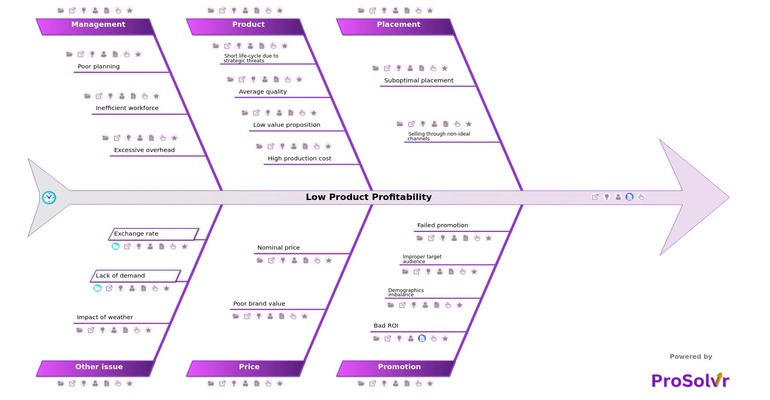Root Cause Analysis of Low Product Profitability
Understanding the intricacies of low product profitability involves a thorough Root Cause Analysis (RCA) approach, utilizing tools such as Fishbone diagrams and the 5 Whys technique, grounded in Six Sigma principles. Profitability fundamentally hinges on the delicate equilibrium between revenue and expenditure, where excessive costs of goods obstruct profit realization. Bloated operating expenses and insufficient income exacerbate this challenge, leaving businesses susceptible to unforeseen losses.
In today's fiercely competitive arena, maintaining robust profit margins is crucial for sustained success. Yet, market dynamics often compel companies to embrace lower margins to remain competitive and attract customers. However, improper pricing strategies can further diminish revenue streams, exacerbating profitability challenges.
Addressing this predicament necessitates a multifaceted strategy, including cost optimization measures such as reducing overheads and conducting comprehensive market research. By delving into the root causes of low profitability and implementing strategic solutions, businesses can fortify their financial resilience and flourish in dynamic market environments.
Moreover, fostering a culture of continuous improvement and data-driven decision-making is paramount. Embracing Six Sigma principles empowers teams to pinpoint inefficiencies, streamline processes, and boost overall productivity. By fostering collaboration across departments and leveraging insights from RCA methodologies like Fishbone diagrams and the 5 Whys, companies can proactively identify and tackle underlying issues. This proactive stance not only enhances profitability but also nurtures a resilient business framework capable of navigating market complexities with agility and foresight.
In conclusion, identifying and addressing the root causes of low product profitability is essential for businesses aiming to thrive in today's competitive landscape. By examining factors such as placement, ROI, product quality, pricing strategies, management practices, and external market influences, organizations can develop comprehensive strategies to improve profitability. Utilizing tools like RCA methodologies and embracing continuous improvement principles such as Six Sigma empowers companies to proactively tackle profitability challenges, foster innovation, and build resilience against market uncertainties. By implementing strategic solutions and fostering a culture of adaptability and data-driven decision-making, businesses can not only enhance their bottom line but also position themselves for sustained success in an ever-evolving business environment.
Who should use the Low Product Profitability template?
- Small Businesses: Owners and managers of small businesses can use this template to identify and address factors contributing to low profitability, enabling them to optimize their operations and enhance financial performance.
- Large Corporations: Executives and teams within large corporations can utilize this template to conduct in-depth analyses of product lines or segments experiencing low profitability, facilitating informed decision-making and strategic planning.
- Startups: Entrepreneurs and founders of startups can leverage this template to evaluate the financial viability of their products and identify areas for improvement early on, helping them to establish a solid foundation for growth.
- Manufacturers and Retailers: Companies involved in manufacturing and retail can apply this template to assess the profitability of their product offerings, identify inefficiencies in production or distribution, and refine pricing and marketing strategies accordingly.
- Service Providers: Businesses offering services rather than physical products can also benefit from this template by examining factors such as pricing structures, client demographics, and operational efficiency to enhance profitability.
Overall, any organization seeking to maximize profitability and sustain long-term growth can benefit from using the Low Product Profitability template as a tool for analysis, problem-solving, and strategic decision-making.
Why use the Low Product Profitability template?
- Identifying Underperforming Products: The template enables businesses to pinpoint specific products or product lines that are contributing to low profitability. By analyzing factors such as costs, pricing, and demand, organizations can identify underperforming products and take appropriate corrective actions.
- Root Cause Analysis: It facilitates a structured approach to conducting root cause analysis (RCA) to uncover the underlying reasons for low profitability. By utilizing tools like Fishbone diagrams and the 5 Whys technique, businesses can delve deep into the root causes of profitability issues and develop targeted solutions.
- Strategic Decision-Making: Armed with insights from the template, businesses can make more informed strategic decisions to improve profitability. Whether it's adjusting pricing strategies, optimizing product placement, or refining marketing efforts, the template provides a framework for decision-making based on data and analysis.
- Resource Allocation: By identifying areas of low profitability, businesses can reallocate resources more effectively to maximize returns. This may involve reallocating marketing budgets, reallocating staffing resources, or investing in initiatives aimed at improving the profitability of specific products or market segments.
- Continuous Improvement: The template promotes a culture of continuous improvement within the organization. By regularly assessing product profitability and implementing corrective actions, businesses can continuously refine their operations and enhance overall profitability over time.
Low Product Profitability template serves as a valuable tool for businesses looking to optimize their product portfolio, increase profitability, and drive sustainable growth.
Draft and create a template for problem analysis in ProSolvr by smartQED.
Curated from community experience and public sources:








